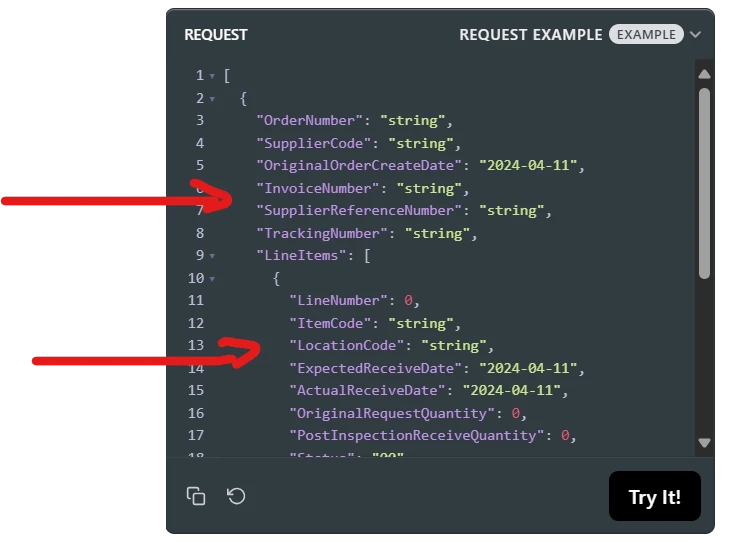Inbound Endpoints & Integration Tasks
This API has various inbound integration endpoints covering master and transactional data sets.
Overview
Dat ais expected to be provided in hierarchical JSON structure allowing up to 1000 records per API call. This limit of 1000 refers to header level records (which means there could be 1000 headers with lines within each). For example, the structure of supply transactions has a hierarchy of header level data and nested line-item data:

The data goes through initial format and structure validation and if the payload is accepted, we respond with a task ID - this is important as it represents the task of importing the data in to GAINS as it flows through the relevant loader and then into the GAINS database. See below for more on Tasks.
By way of example:
- Client pushes 500 records via API at 8am
- Client pushed another 500 records via API at 8.20am
- Both of the above will have a unique task ID assigned and they will be in
queuedstatus - Later in the data, based on GAINS configuration, the data is processed by the loader and ingested in to GAINS
Validation Checks at the API Level
Before the data is fed into it's respective loader, there will be some initial checks at the API level. These include:
- Payload size checks - number of objects - to be within the limit
- Structure checks - required fields and keys need to be present
- Security checks / sanitary checks
- Value range checks - certain values to fall within specific range/limit
Task Stages
Tasks can be in the following stages:
received: the data was submitted by the client and received by GAINS APIqueued: the data has been queued for processing and has an expected processing timeprocessing: the data is being processedcompleted: the data has come out of the loaders and we can indicate whether the dataset was accepted, rejected, etc. Example, 1000 lines total, 23 rejected with reason, 977 acceptedrejected: when the entire payload is rejected either before, during or after processing along with a reason for the rejectcancelled: based on client desire to cancel an unprocessed task
At the moment, all task monitoring and management is done via API - see Task endpoints.
Task Response Model
When a task is initially submitted, the response will contain the following attributes, assuming the payload was queued:
{
"Status": "Queued",
"TaskId": "c2791b62-508f-4aaa-b011-3764ff4625ee"
}In the event the payload fails initial validation, the response will provide details:
{
"Status": "Rejected",
"RejectedRecords": [
{
"Record": {
"LocationCode": "",
"Name": "string",
"Type": "string",
"ParentDefaultCode": "string",
"Address1": "string",
"Address2": "string",
"City": "string",
"State": "string",
"Country": "string",
"PostalCode": "string",
"Latitude": 0.0,
"Longitude": 0.0,
"StartDate": "2024-12-09",
"EndDate": "2024-12-09",
"Size": "string",
"CurrencyCode": "string",
"ExtendedData": null
},
"Reasons": [
"LocationCode must be between 1 and 80 characters. (path: LocationCode)"
]
}
]
}Thereafter, when retrieving status of any task, the response model is documented in the GET tasks/{id} endpoint
Rejected Records
Review the detailed post on how you can expect to see records that have been rejected and handling these in an appropriate way.
Updated 7 months ago
